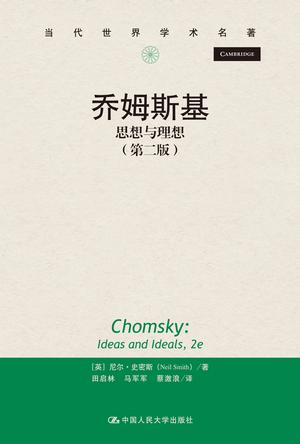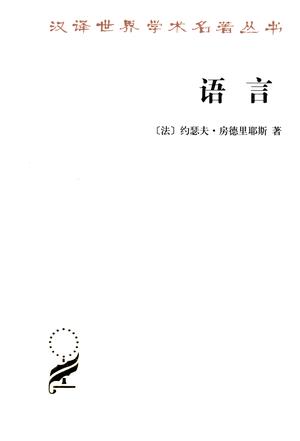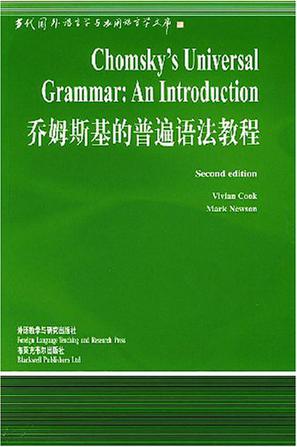-

乔姆斯基
《乔姆斯基:思想与理想》一书并非乔姆斯基的人生传记,而是全面客观地介绍他的思想,如天赋论、刺激贫乏论、内在语言、心智主义等。对乔姆斯基的深邃见解有的学者投以赞赏,主动加入阵营;有的横加批判,敌意尽现。至于这些争议是否允当,全凭读者评判,公道自在人心。不过,阅读本书,更触动我们的是乔姆斯基突破常规、不断创新的精神,敢于挑战自我、否定自我的魄力,以及在捍卫民众权益时表现出的知识分子的责任感和正义感。 -

如何以言行事
《如何以言行事》阐述了言语行为理论,主要是讨论述谓话语与施事话语的区别以及使施事句适切的必要条件和导致其不适切的各种因素。这12章分别阐述施事话语与述谓话语;恰当施事话语的条件;情境欠缺:未成;情境欠缺:滥用;判断施事话语的可能标准;显式施事话语;显式施事话语动词;说话行为、施事行为和取效行为;施事行为和取效行为的区分;话语施事行为与话语施效行为;陈述话语、施事话语、施事行为;语力的分类。 -

语言
该书把读者引入了语言科学的源泉。语言科学处在心理学、社会学和历史学的十字路口,这门学科还有太多人没有对它产生足够的兴趣。语言产生于生活,产生以后又不断收到生活的哺育。但是产生于生活、担负着全部表情感任务的语言,还能容许思想作巨大的飞跃。 -

语言人
编辑推荐:本书理论思考让位于具体事实。在一个逐步明确的主题下,讨论分三个阶段展开。第一部分(上篇)首先介绍当前对语言行为的研究的几个主要方向。第二部分(中篇)谈谈语言学对了解人类有哪些重要贡献。第三部分(下编)阐明可在此基础上建立的有关人和社会的语言学理论。通贯全书的是一个含有互动意义的概念:对话。它是整个撰写过程的依归,并引导讨论的展开。本书有一个明确的目标:揭示语言学在“什么是人”这个课题上能 -

乔姆斯基的普遍语法教程
Cook and Newson have written an extremely clear and highly comprehensible introduction to current syntactic theory. This text makes accessible many subtleties of linguistic argumentation, and explains in plain Eenglish the reasoning involved. The second edition greatly improves on the first edition, both in depth and scope, with much new material added and many confusing points clarified. The chapter on the “Minimalist Programme” is the most lucid explication of Chomsky's reccnt writings that I am aware of,Steven Franks, Indiana University . Chomsky's Universal Crammar introduces both the general concepts of the theory particularly its goals of describing the knowledge of language and of accounting for how it is acquired, and the main areas of syntax such as X-bar theory, movement and government. Like the first edition, it puts the technicalities of the theory in the context of its wider ideas in a manner that makes them accessible to the student. The new edition is based on the current model of syntax that is most widely accepted, incorporating Barriers syntax, functional categories, and Relativized Minimality, and their implications for language acquisition. Further, it provides a sketch of the model in the process of development, the Minimalist Programme, with its attempt to reduce the theory to the minimal essentials. -

Logic, Language, and Meaning, Volume 1
Although the two volumes of "Logic, Language, and Meaning" can be used independently of one another, together they provide a comprehensive overview of modern logic as it is used as a tool in the analysis of natural language. Both volumes provide exercises and their solutions. Volume 1, "Introduction to Logic," begins with a historical overview and then offers a thorough introduction to standard propositional and first-order predicate logic. It provides both a syntactic and a semantic approach to inference and validity, and discusses their relationship. Although language and meaning receive special attention, this introduction is also accessible to those with a more general interest in logic. In addition, the volume contains a survey of such topics as definite descriptions, restricted quantification, second-order logic, and many-valued logic. The pragmatic approach to non-truthconditional and conventional implicatures are also discussed. Finally, the relation between logic and formal syntax is treated, and the notions of rewrite rule, automation, grammatical complexity, and language hierarchy are explained.